Yesterday we had a blast on Antelope Island while photographing two different subjects I have very little experience with – hummingbirds and butterflies. Whether they’re my images or those of others I’ve always preferred hummingbird images taken in natural surroundings rather than set up and/or in a back yard setting and I much prefer natural light over flash.
There almost seems to be a distinct genre of bird photography involving hummingbirds which includes the use of elaborate setups to get that perfect, uncluttered background and multiple flashes to freeze those whirring wings. Such methods often produce beautiful images but for me they typically have that “setup feel” that doesn’t much appeal to me.
The trade-off with going “au natural” is that one can’t be as fussy about the setting or background and the wings will often show motion blur but I like the wing blur often present in hummer images taken sans flash – those little wings go so fast that the blur seems natural to my eye. And since hummingbirds images are often taken among flowers, the background colors can often be very colorful – to the point of competing with the bird. I may have pushed that envelope to the limits here.
1/2000, f/5.6, ISO 400, 500 f/4, 1.4 tc, natural light
I’ll admit off the top that I’m so inexperienced with hummingbirds that I haven’t even been able to positively identify the species I’m presenting here. I think I’ve narrowed it down to either Rufous or Calliope but I’d appreciate any help from others on ID. I despise having to use my “unidentified ID” folder…
These birds were buzzing frantically over clumps of Rocky Mountain Bee Plant, a species of Cleome that produces copious amounts of nectar so it attracts hummingbirds, butterflies, bees and wasps. All four were there yesterday.
1/2500, f/5.6, ISO 400, 500 f/4, 1.4 tc, natural light
As a biologist I enjoyed watching the natural processes at work here. The long, showy pollen tipped stamens and deeply buried nectar, when combined with the long bill of the bird, are the perfect combination to suit some of the biological needs of each species. The hummers were often covered with pollen.
1/2500, f/5.6, ISO 400, 500 f/4, 1.4 tc, natural light
Normally I’d delete most any photo where the head of my subject is hidden but it can be seen just well enough through the diaphanous veil of the wing feathers that the image works for me.
1/2000, f/5.6, ISO 400, 500 f/4, 1.4 tc, natural light
Occasionally the birds would land close enough on twig perches to rest and stretch. This one gave me a variety of interesting poses.
1/1600, f/6.3, ISO 400, 500 f/4, 1.4 tc, natural light
The butterflies were there in abundance, too – especially Monarchs. I’d never before seen butterflies chasing hummingbirds but it happened several times yesterday.
1/2500, f/6.3, ISO 400, 500 f/4, 1.4 tc, natural light
I believe this is the female Monarch.
1/1600, f/5.6, ISO 400, 500 f/4, 1.4 tc, natural light
Yesterday was great fun! It’s been so slow on the island for so long now (the August doldrums) that both Mia and I were beginning to believe that “skunked” was our middle names.
But yesterday the only smell out there was the “lake stink”…
Ron


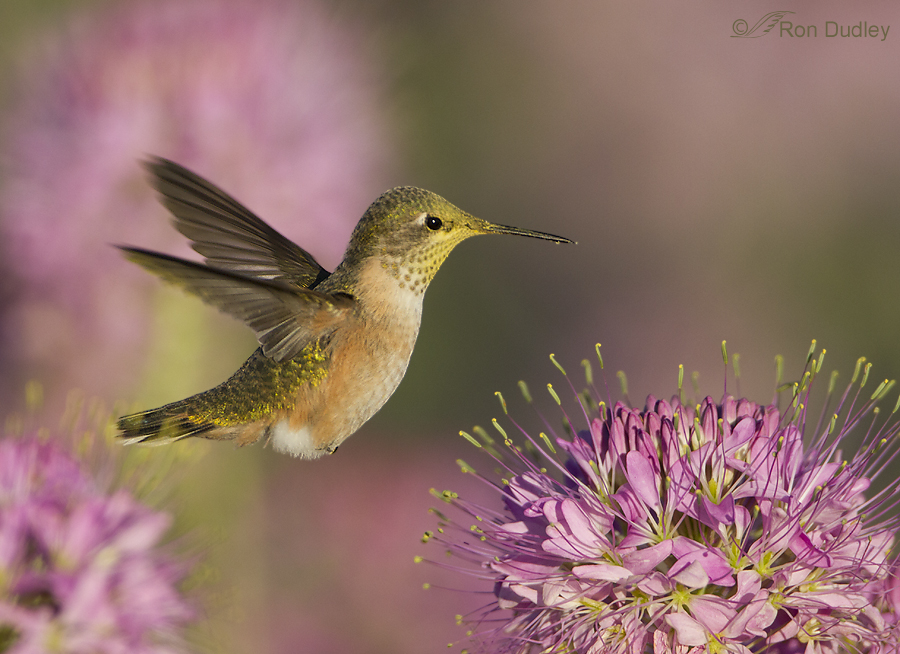
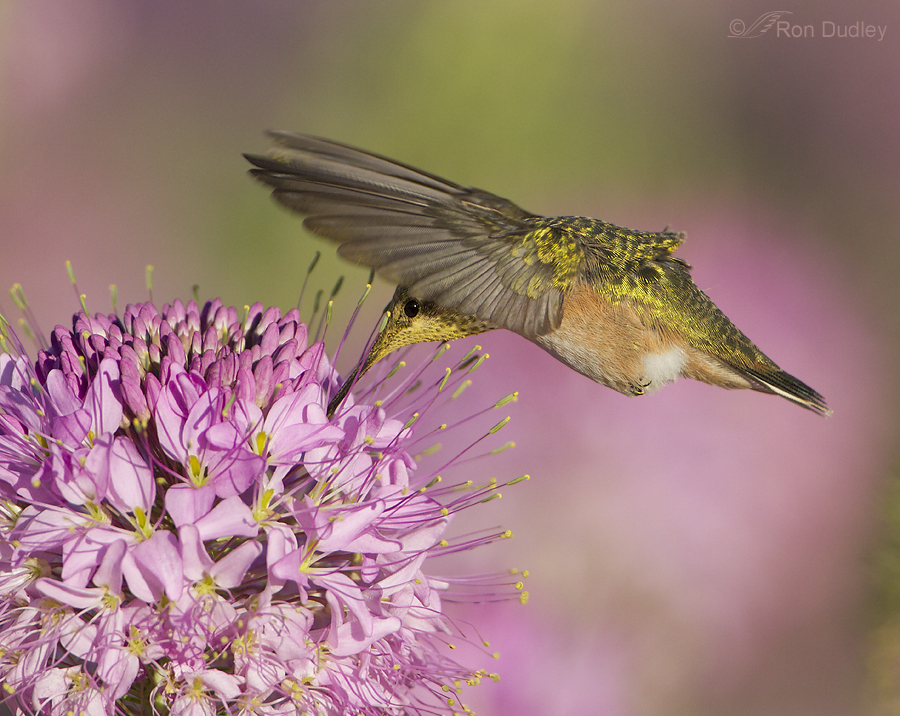
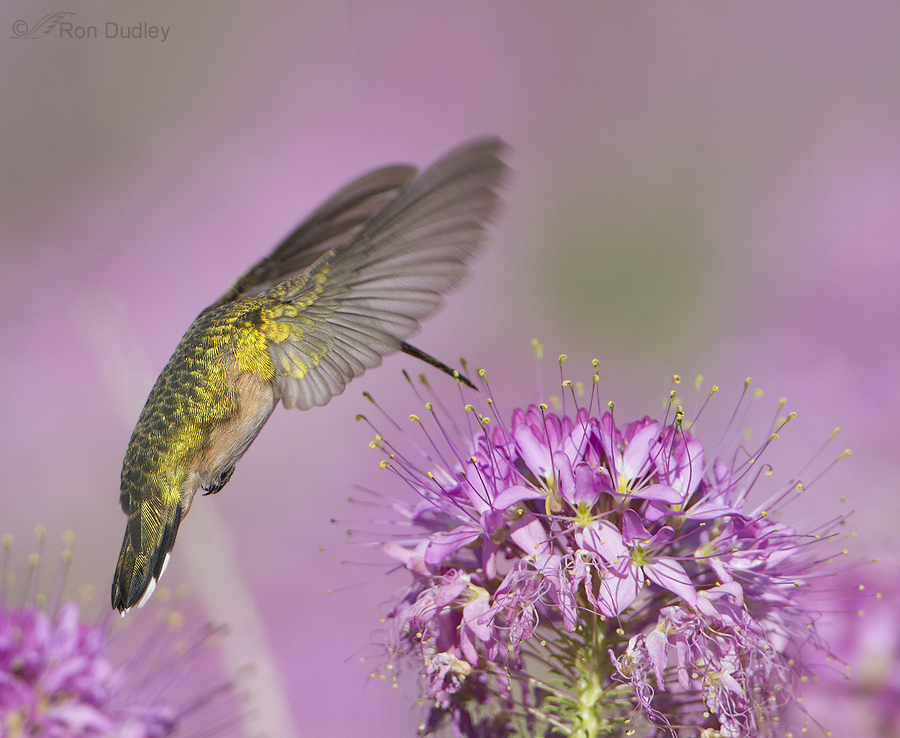
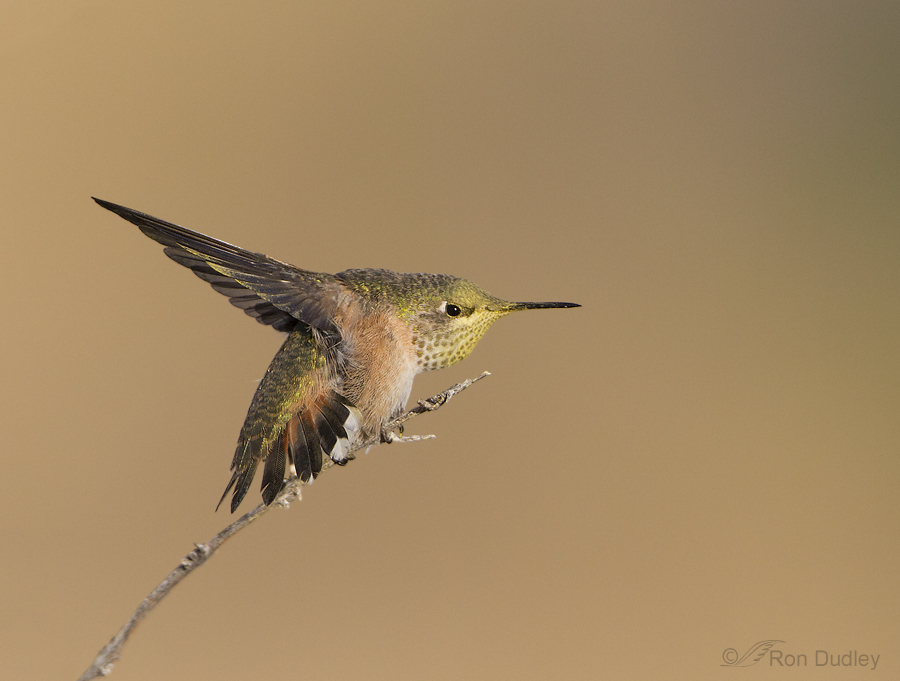
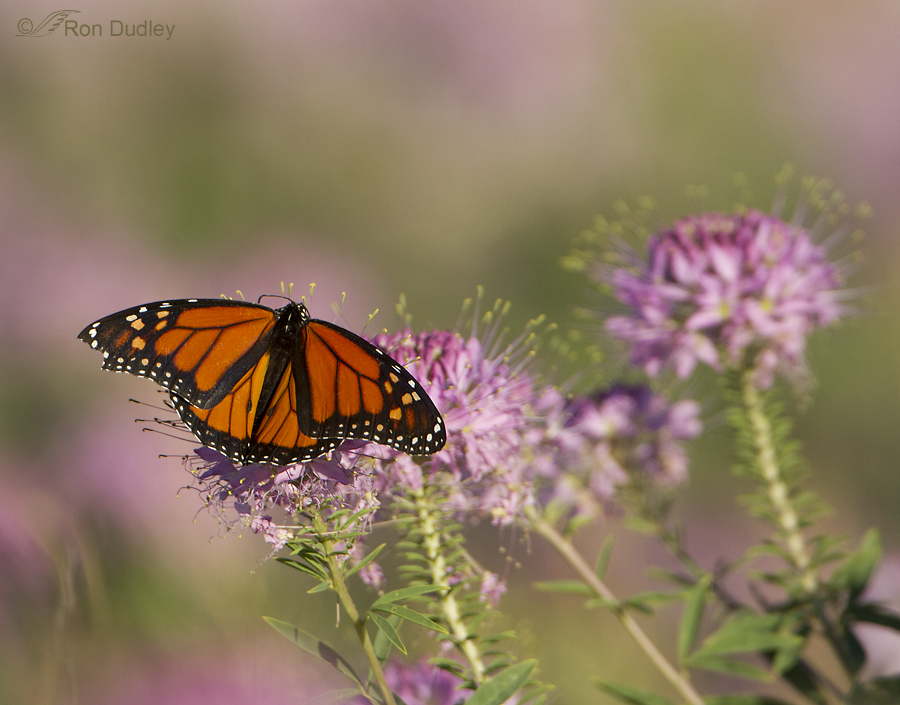
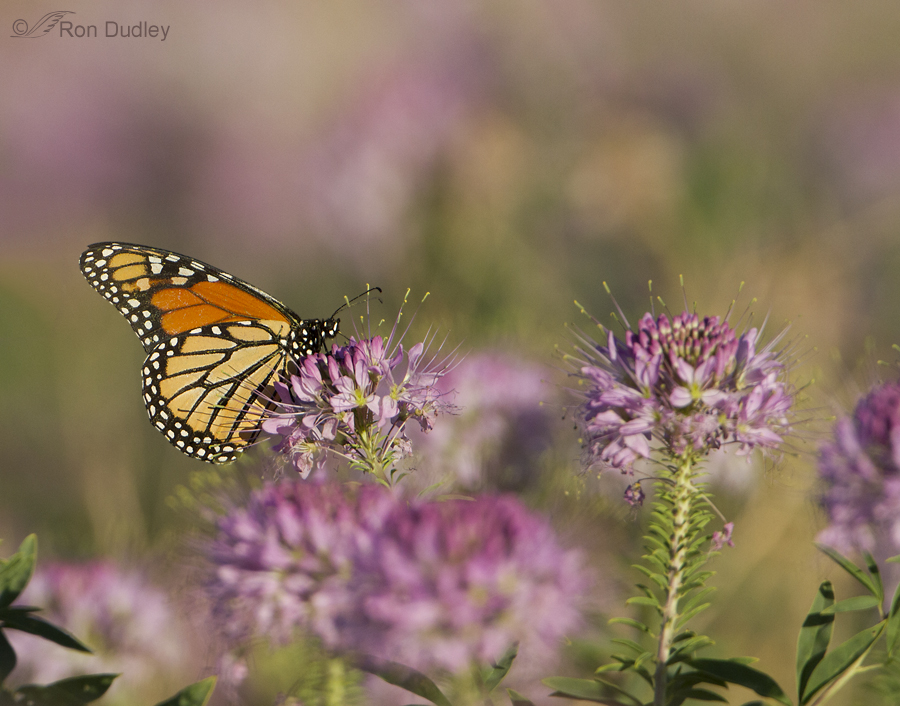
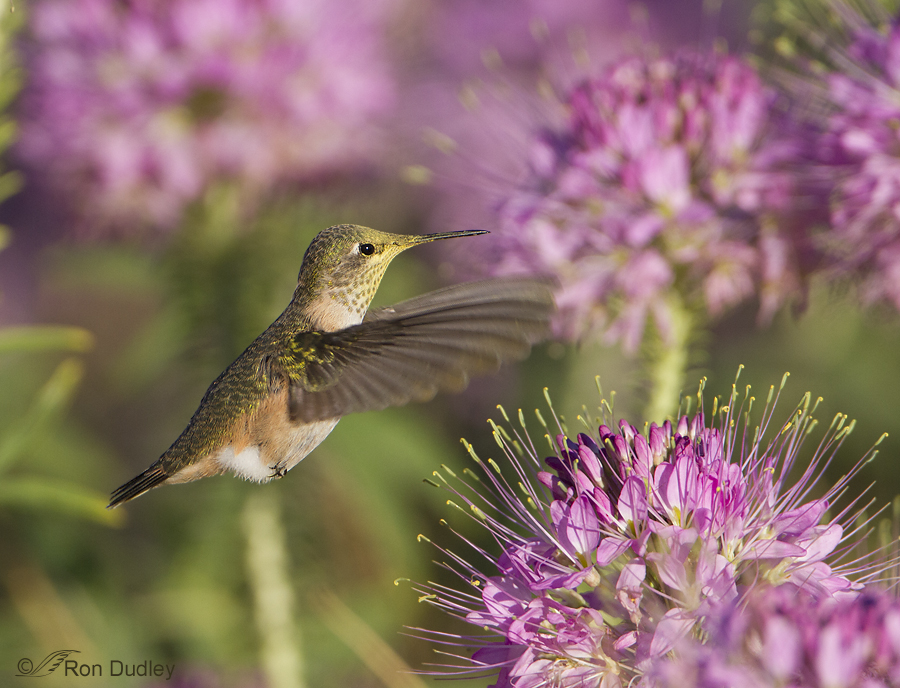
Wonderful pictures. I’ve wondered as to the species of hummingbirds we’ve had in the garden at the fire chalice and agastache this year, and it would seem to be either the rufous or calliope hummingbirds. This is interesting in that the four previous summers since planting flowers to attract hummingbirds we’ve seen almost exclusively black throated and, far less frequently, ruby throated hummingbirds. This year, however, we’ve seen almost none of the black- or ruby-throated h’birds and almost exclusively the calliopes and/or rufous types. Have others seen such a difference this year?
First I can say one thing for sure…Excellent images, Ron! Now for the just my opinion part…Here’s my opinion after studying a few Calliope’s that visited my front porch feeder in recent weeks. They were studied side by side with Rufous Hummingbirds. I think you can rule out Rufous because the feathers on each side of the central tail feathers lack the notch seen on Rufous. Rufous would also show rufous coloring on the side of the rump area of the bird and much more in the tail feathers. Rufous also show a distinct white collar between throat and rufous sides and chest area. The tail of a rufous also comes to a point when the tail is closed. I would expect the tail to be longer relative to the wings when perched and more rounded than shown in these photos to be a Broad-tailed Hummingbird. I believe this is a Calliope based on the overall buffy color of the underside, the two central tail feathers being solid black and shorter than the other tail feathers and the tail being flatter along the bottom edge when fanned. The hump on the lower back and quick drop to a short tail have the shape I’ve seen on Calliopes. The one thing I’d like to see with Calliope is the white feathers at the base and edge of upper mandible. I think that could be hidden due to the amount of pollen on the birds bill and gape area. I believe I can see the thin black line (similar to the greater than > sign) between the eye and the bill. Another thing I think I’ve picked up on for Calliope is how the green spots on the throats of juvenile males and females seem finer and terminate with a flare to the outside of the neck where those marks on Rufous and BT Hummingbirds seem to be bolder and more vertically oriented down the throat. Interested in seeing comments from those with more experience.
Thanks very much, Jeff. You’ve looked at this very carefully and I appreciate it. I’m a neophyte at hummer ID so I’m just sitting back and learning…
I want to add a couple comments. My previous comments were based on looking at the images on both Ron Dudley’s and Mia McPherson’s blogs. So some of my comments here refer to the tail when not fanned. Those comments are based on Mia’s perched images. Sorry if that confused anyone. Ron’s image with the head veiled has characteristics of a Broad-tailed Hummingbird. There are long iridescent central feathers and the bill appears to be longer than those in other images. It could be the same bird in Ron’s image of the perched bird stretching (much more rufous in the upper part of the four outer tail feathers as expected for Broad-tailed.)
Thank you Ron, Thank you Mia. I have had a double dose of these beauties today.
One of our butterflies (The Orchard Butterfly) is so territorial that the males will apparently chase anything black and white (including magpies!!!) which enter their territory. Which would give it a limited future I expect.
Fascinating butterfly behavior you’ve described, Elephant’s Child. I assume from what you’ve said that the Orchard Butterfly is also black and white…
Sorry, I should have said. Yes, it is (mostly) black and white.
I really enjoyed your “departure” series! Can’t help with the i.d., we get very limited hummers here in swamp land. I especially like your “no set up” images. After all, Nature is the ultimate artist. You have captured Her well.
Thanks, everyone – for the comments and the ideas regarding ID. Doesn’t look like there’s a consensus yet but Calliope seems to be in the forefront.
It’s been crazy around here (running computers into the shop and losing electricity, for starters – power just now came on) so I hope you’ll bear with me if I don’t respond to each individual comment. I’m definitely behind the 8-ball…
Ron, I don’t know what sources you use, but when I looked at Sibley, the amount of rufous color on the tail seemed to be the key. The Calliope doesn’t have that.
Susan, I’ve been using both Sibley’s, National Geographic, American Museum of Natural History and an older Audubon. I just can’t tell for sure – too many variables for me when you include females, juveniles and individual variations.
Maybe part of the reason I’ve largely avoided photographing hummingbirds in the past is that I’m intimidated by their ID… 🙂
Can’t blame you for being intimidated by the ID process. No matter how much you do it, some creatures just are not easy. Ditto for some plants like the fern I’m currently having difficulty with. Whatever the bird is, she is gorgeous. No doubt there!
I also considered the 4th shot on the limb as being a Rufous, but the length of the bill & tail made me doubtful. I use Kaufman & Peterson guides-Kaufman being my favorite. There’s no question this is a tough call!
GORGEOUS photos, Ron! So clear, great color.
Fantastic hummingbird photos. Who needs set-ups when you can get shots like this. Of course, you don’t get the opportunity very often, and that makes these SO special.
Interesting to see everybody’s take on the hummer ID. Looking at the tail, I would say it is a female Rufous Hummingbird. The overall colors don’t work for anything else. Based on what I’ve seen in my field guides, the color is all wrong for Broad-billed, in addition to the range.
Whatever she is, this is a gorgeous bird and the photos are just amazing. Especially given that you said you don’t have much experience photographing hummers. The detail you’ve captured is wonderful.
On the monarch butterflies, the sexual identifier for the male is the little black spot on the most medial vein of the lower wing. Females don’t have that. So your ID of the second one as a female is correct (butterflies have been a life-long passion for me).
Gorgeous photos Ron!!!
I love your hummers! And Mia’s too!!
calliope for sure … can’t tell from photo whether immature bird which typically has visible ridges along upper mandible.
you no longer can say you have no or luttle experience … truly awesome photos! the light, the frames, the focus. magnifico!
cheers
dawna
san francisco
Beautiful! Butterflies chasing hummingbirds – wow, that must be something to see!
Spectacular Ron!
Ron, Great photos! I would say these are immature Calliope’s. My #1&2 reasons are bill and tail length. I think Dick may have meant Broad-TAILED not Billed. The range is correct for them, but I think you would see more of an eye ring & the tail & bill are considerably longer. JMO. DEB
Hi Ron: This looks like a female rufous to me. The tail is distinctive as is the coloration at the base of the wings. I don’t believe it is a female broad tailed.
I’ve really enjoyed both your post and Mia’s, and your use of natural light. Naturally I can’t help with the i.d. but will be interested to know the final decision. Hopefully people will put why they reached their decision, so that I can learn too.
I believe you have either a Calliope Hummingbird female/immature or a Broad-billed Hummingbird female/immature. The primary difference between the two is that the Calliope has a shorter bill and tail and is generally smaller. Since I have only seen these two a long time ago, I can’t be certain, but I lean toward a Broad-billed. Hopefully someone with more expertise will chime in. And, of course you have a Monarch.
Excellent shots Ron, beautiful composition and DOF on all.
Thank you, Dick. I didn’t consider Broad-billed as a possibility because the range maps don’t show them in northern Utah…